Analyzing Strategy and Change Management in Barclays plc Bank
VerifiedAdded on 2023/06/17
|14
|2980
|459
Report
AI Summary
This report provides a detailed analysis of strategy and change management at Barclays Bank, a British multinational universal bank. It defines strategy and discusses the benefits of Barclays' strategies, including customer focus, digitalization, diversification, and culture. The report examines the strategy planning process using William's model and the impact of purpose, vision, and mission. A PESTLE and SWOT analysis outlines the bank's business environment, followed by an exploration of why and what triggers change, utilizing Kotter's change management model. The report also covers strategies for managing change and risk at various levels and identifies KPIs for dealing with change, ultimately concluding on the importance of effective change management for organizational success. Desklib provides past papers and solved assignments for students.
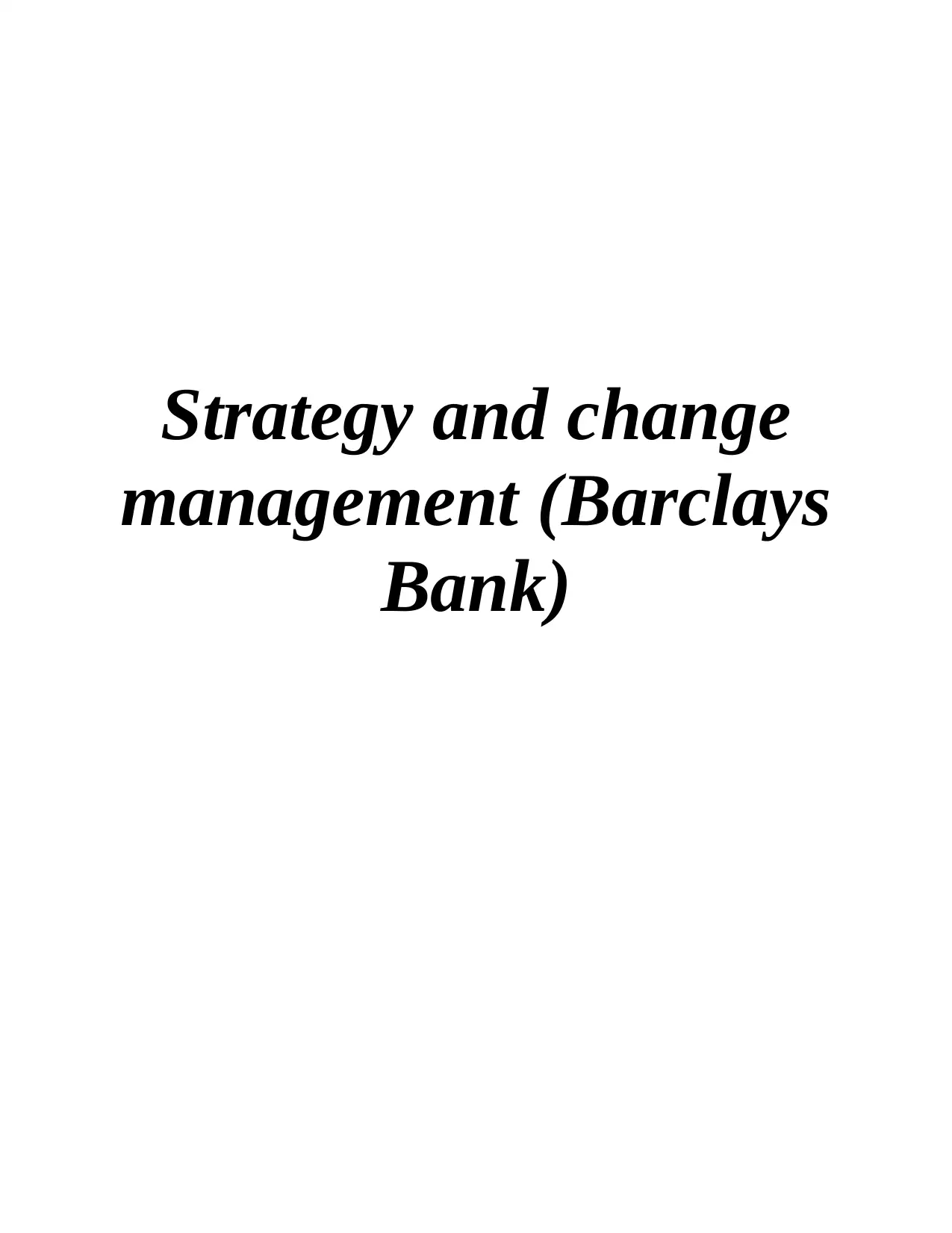
Strategy and change
management (Barclays
Bank)
management (Barclays
Bank)
Paraphrase This Document
Need a fresh take? Get an instant paraphrase of this document with our AI Paraphraser
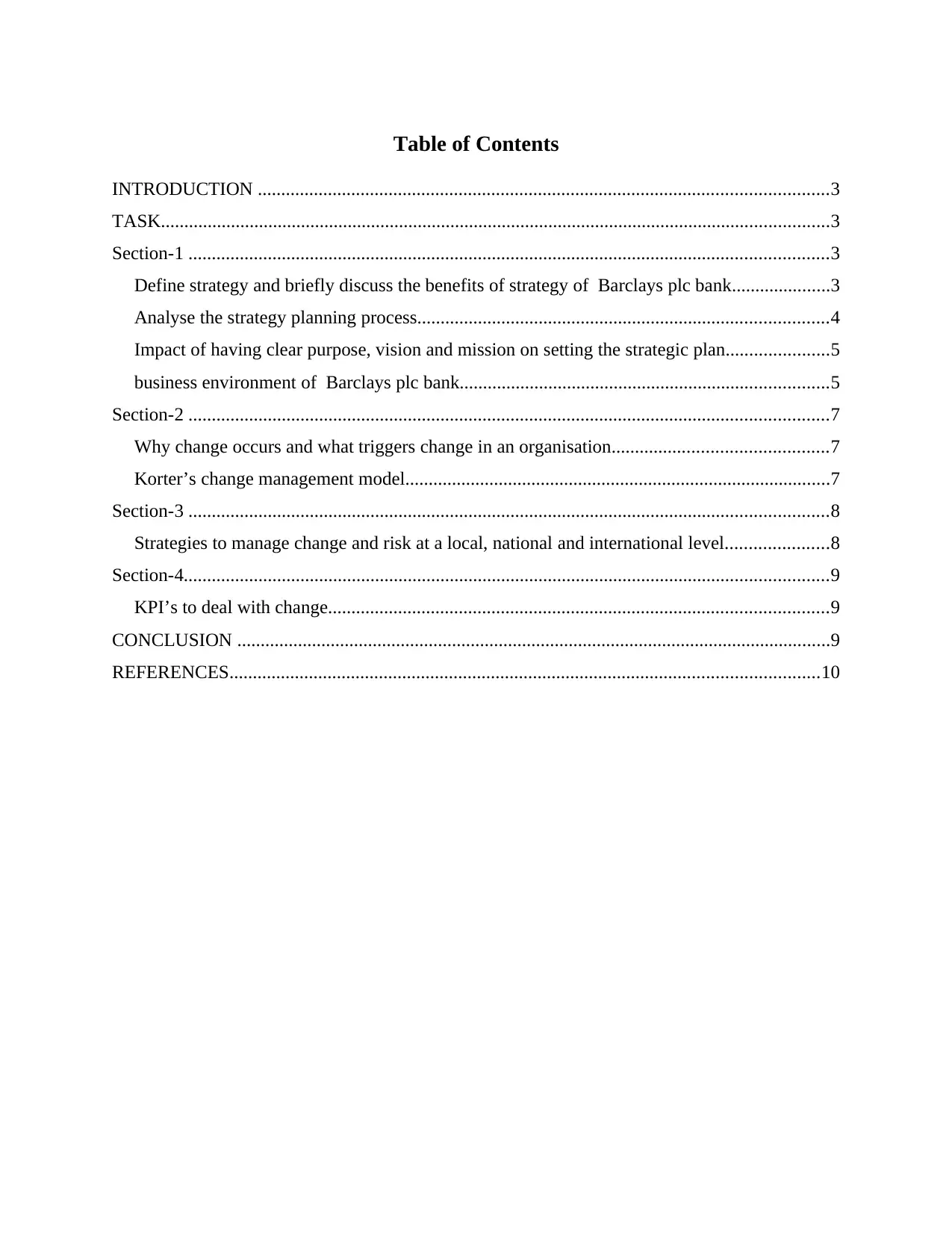
Table of Contents
INTRODUCTION ..........................................................................................................................3
TASK...............................................................................................................................................3
Section-1 .........................................................................................................................................3
Define strategy and briefly discuss the benefits of strategy of Barclays plc bank.....................3
Analyse the strategy planning process........................................................................................4
Impact of having clear purpose, vision and mission on setting the strategic plan......................5
business environment of Barclays plc bank...............................................................................5
Section-2 .........................................................................................................................................7
Why change occurs and what triggers change in an organisation..............................................7
Korter’s change management model...........................................................................................7
Section-3 .........................................................................................................................................8
Strategies to manage change and risk at a local, national and international level......................8
Section-4..........................................................................................................................................9
KPI’s to deal with change...........................................................................................................9
CONCLUSION ...............................................................................................................................9
REFERENCES..............................................................................................................................10
INTRODUCTION ..........................................................................................................................3
TASK...............................................................................................................................................3
Section-1 .........................................................................................................................................3
Define strategy and briefly discuss the benefits of strategy of Barclays plc bank.....................3
Analyse the strategy planning process........................................................................................4
Impact of having clear purpose, vision and mission on setting the strategic plan......................5
business environment of Barclays plc bank...............................................................................5
Section-2 .........................................................................................................................................7
Why change occurs and what triggers change in an organisation..............................................7
Korter’s change management model...........................................................................................7
Section-3 .........................................................................................................................................8
Strategies to manage change and risk at a local, national and international level......................8
Section-4..........................................................................................................................................9
KPI’s to deal with change...........................................................................................................9
CONCLUSION ...............................................................................................................................9
REFERENCES..............................................................................................................................10
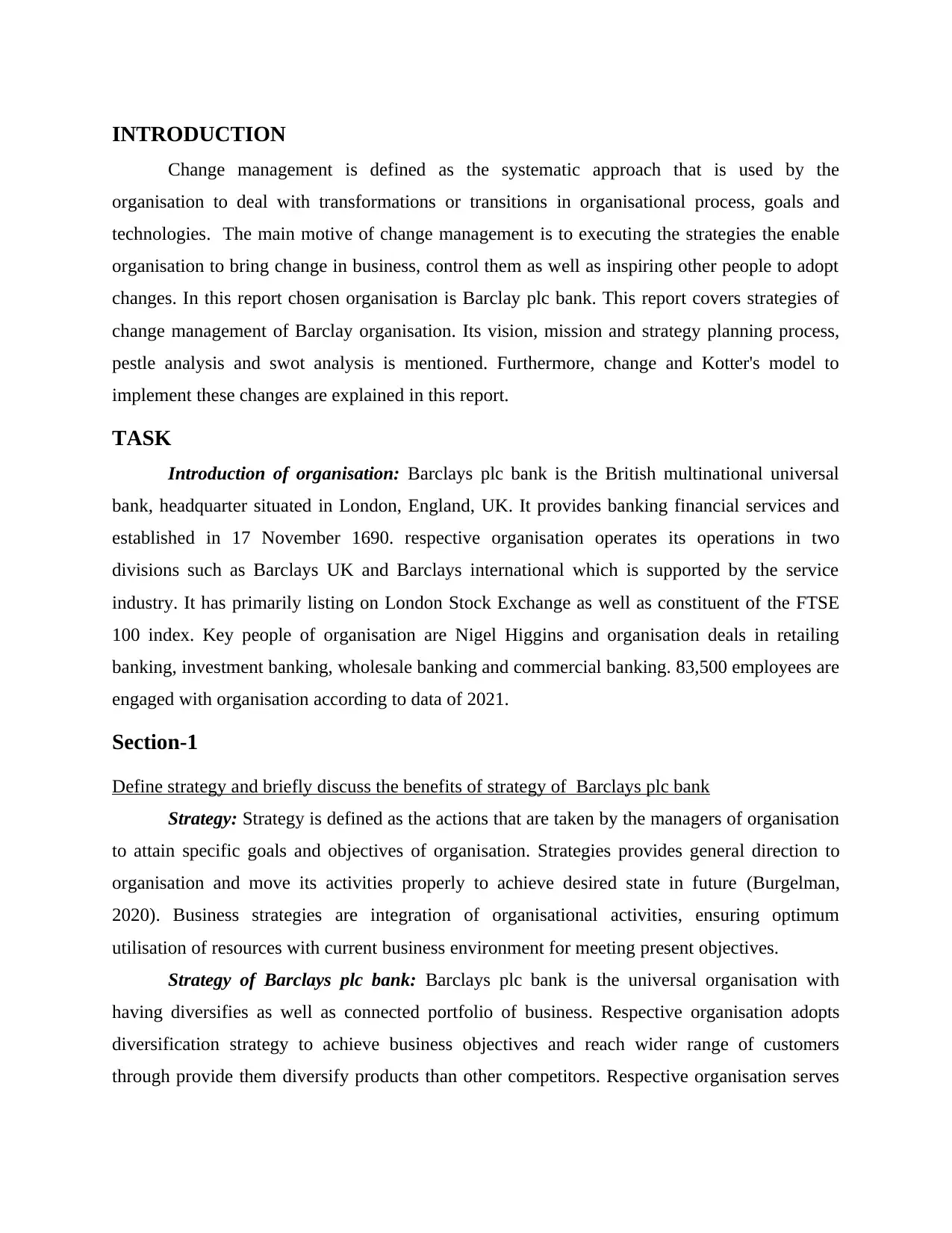
INTRODUCTION
Change management is defined as the systematic approach that is used by the
organisation to deal with transformations or transitions in organisational process, goals and
technologies. The main motive of change management is to executing the strategies the enable
organisation to bring change in business, control them as well as inspiring other people to adopt
changes. In this report chosen organisation is Barclay plc bank. This report covers strategies of
change management of Barclay organisation. Its vision, mission and strategy planning process,
pestle analysis and swot analysis is mentioned. Furthermore, change and Kotter's model to
implement these changes are explained in this report.
TASK
Introduction of organisation: Barclays plc bank is the British multinational universal
bank, headquarter situated in London, England, UK. It provides banking financial services and
established in 17 November 1690. respective organisation operates its operations in two
divisions such as Barclays UK and Barclays international which is supported by the service
industry. It has primarily listing on London Stock Exchange as well as constituent of the FTSE
100 index. Key people of organisation are Nigel Higgins and organisation deals in retailing
banking, investment banking, wholesale banking and commercial banking. 83,500 employees are
engaged with organisation according to data of 2021.
Section-1
Define strategy and briefly discuss the benefits of strategy of Barclays plc bank
Strategy: Strategy is defined as the actions that are taken by the managers of organisation
to attain specific goals and objectives of organisation. Strategies provides general direction to
organisation and move its activities properly to achieve desired state in future (Burgelman,
2020). Business strategies are integration of organisational activities, ensuring optimum
utilisation of resources with current business environment for meeting present objectives.
Strategy of Barclays plc bank: Barclays plc bank is the universal organisation with
having diversifies as well as connected portfolio of business. Respective organisation adopts
diversification strategy to achieve business objectives and reach wider range of customers
through provide them diversify products than other competitors. Respective organisation serves
Change management is defined as the systematic approach that is used by the
organisation to deal with transformations or transitions in organisational process, goals and
technologies. The main motive of change management is to executing the strategies the enable
organisation to bring change in business, control them as well as inspiring other people to adopt
changes. In this report chosen organisation is Barclay plc bank. This report covers strategies of
change management of Barclay organisation. Its vision, mission and strategy planning process,
pestle analysis and swot analysis is mentioned. Furthermore, change and Kotter's model to
implement these changes are explained in this report.
TASK
Introduction of organisation: Barclays plc bank is the British multinational universal
bank, headquarter situated in London, England, UK. It provides banking financial services and
established in 17 November 1690. respective organisation operates its operations in two
divisions such as Barclays UK and Barclays international which is supported by the service
industry. It has primarily listing on London Stock Exchange as well as constituent of the FTSE
100 index. Key people of organisation are Nigel Higgins and organisation deals in retailing
banking, investment banking, wholesale banking and commercial banking. 83,500 employees are
engaged with organisation according to data of 2021.
Section-1
Define strategy and briefly discuss the benefits of strategy of Barclays plc bank
Strategy: Strategy is defined as the actions that are taken by the managers of organisation
to attain specific goals and objectives of organisation. Strategies provides general direction to
organisation and move its activities properly to achieve desired state in future (Burgelman,
2020). Business strategies are integration of organisational activities, ensuring optimum
utilisation of resources with current business environment for meeting present objectives.
Strategy of Barclays plc bank: Barclays plc bank is the universal organisation with
having diversifies as well as connected portfolio of business. Respective organisation adopts
diversification strategy to achieve business objectives and reach wider range of customers
through provide them diversify products than other competitors. Respective organisation serves
⊘ This is a preview!⊘
Do you want full access?
Subscribe today to unlock all pages.

Trusted by 1+ million students worldwide
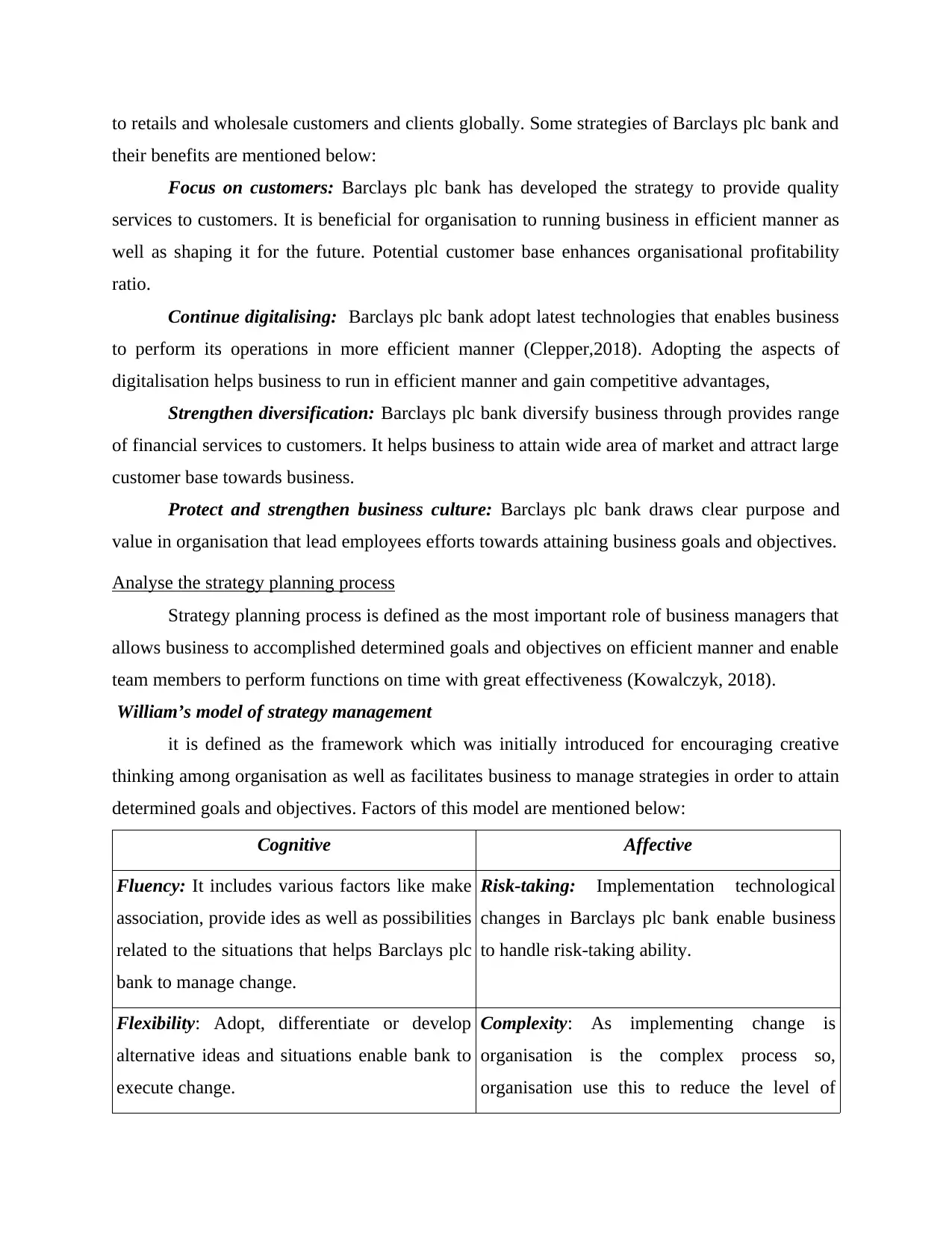
to retails and wholesale customers and clients globally. Some strategies of Barclays plc bank and
their benefits are mentioned below:
Focus on customers: Barclays plc bank has developed the strategy to provide quality
services to customers. It is beneficial for organisation to running business in efficient manner as
well as shaping it for the future. Potential customer base enhances organisational profitability
ratio.
Continue digitalising: Barclays plc bank adopt latest technologies that enables business
to perform its operations in more efficient manner (Clepper,2018). Adopting the aspects of
digitalisation helps business to run in efficient manner and gain competitive advantages,
Strengthen diversification: Barclays plc bank diversify business through provides range
of financial services to customers. It helps business to attain wide area of market and attract large
customer base towards business.
Protect and strengthen business culture: Barclays plc bank draws clear purpose and
value in organisation that lead employees efforts towards attaining business goals and objectives.
Analyse the strategy planning process
Strategy planning process is defined as the most important role of business managers that
allows business to accomplished determined goals and objectives on efficient manner and enable
team members to perform functions on time with great effectiveness (Kowalczyk, 2018).
William’s model of strategy management
it is defined as the framework which was initially introduced for encouraging creative
thinking among organisation as well as facilitates business to manage strategies in order to attain
determined goals and objectives. Factors of this model are mentioned below:
Cognitive Affective
Fluency: It includes various factors like make
association, provide ides as well as possibilities
related to the situations that helps Barclays plc
bank to manage change.
Risk-taking: Implementation technological
changes in Barclays plc bank enable business
to handle risk-taking ability.
Flexibility: Adopt, differentiate or develop
alternative ideas and situations enable bank to
execute change.
Complexity: As implementing change is
organisation is the complex process so,
organisation use this to reduce the level of
their benefits are mentioned below:
Focus on customers: Barclays plc bank has developed the strategy to provide quality
services to customers. It is beneficial for organisation to running business in efficient manner as
well as shaping it for the future. Potential customer base enhances organisational profitability
ratio.
Continue digitalising: Barclays plc bank adopt latest technologies that enables business
to perform its operations in more efficient manner (Clepper,2018). Adopting the aspects of
digitalisation helps business to run in efficient manner and gain competitive advantages,
Strengthen diversification: Barclays plc bank diversify business through provides range
of financial services to customers. It helps business to attain wide area of market and attract large
customer base towards business.
Protect and strengthen business culture: Barclays plc bank draws clear purpose and
value in organisation that lead employees efforts towards attaining business goals and objectives.
Analyse the strategy planning process
Strategy planning process is defined as the most important role of business managers that
allows business to accomplished determined goals and objectives on efficient manner and enable
team members to perform functions on time with great effectiveness (Kowalczyk, 2018).
William’s model of strategy management
it is defined as the framework which was initially introduced for encouraging creative
thinking among organisation as well as facilitates business to manage strategies in order to attain
determined goals and objectives. Factors of this model are mentioned below:
Cognitive Affective
Fluency: It includes various factors like make
association, provide ides as well as possibilities
related to the situations that helps Barclays plc
bank to manage change.
Risk-taking: Implementation technological
changes in Barclays plc bank enable business
to handle risk-taking ability.
Flexibility: Adopt, differentiate or develop
alternative ideas and situations enable bank to
execute change.
Complexity: As implementing change is
organisation is the complex process so,
organisation use this to reduce the level of
Paraphrase This Document
Need a fresh take? Get an instant paraphrase of this document with our AI Paraphraser
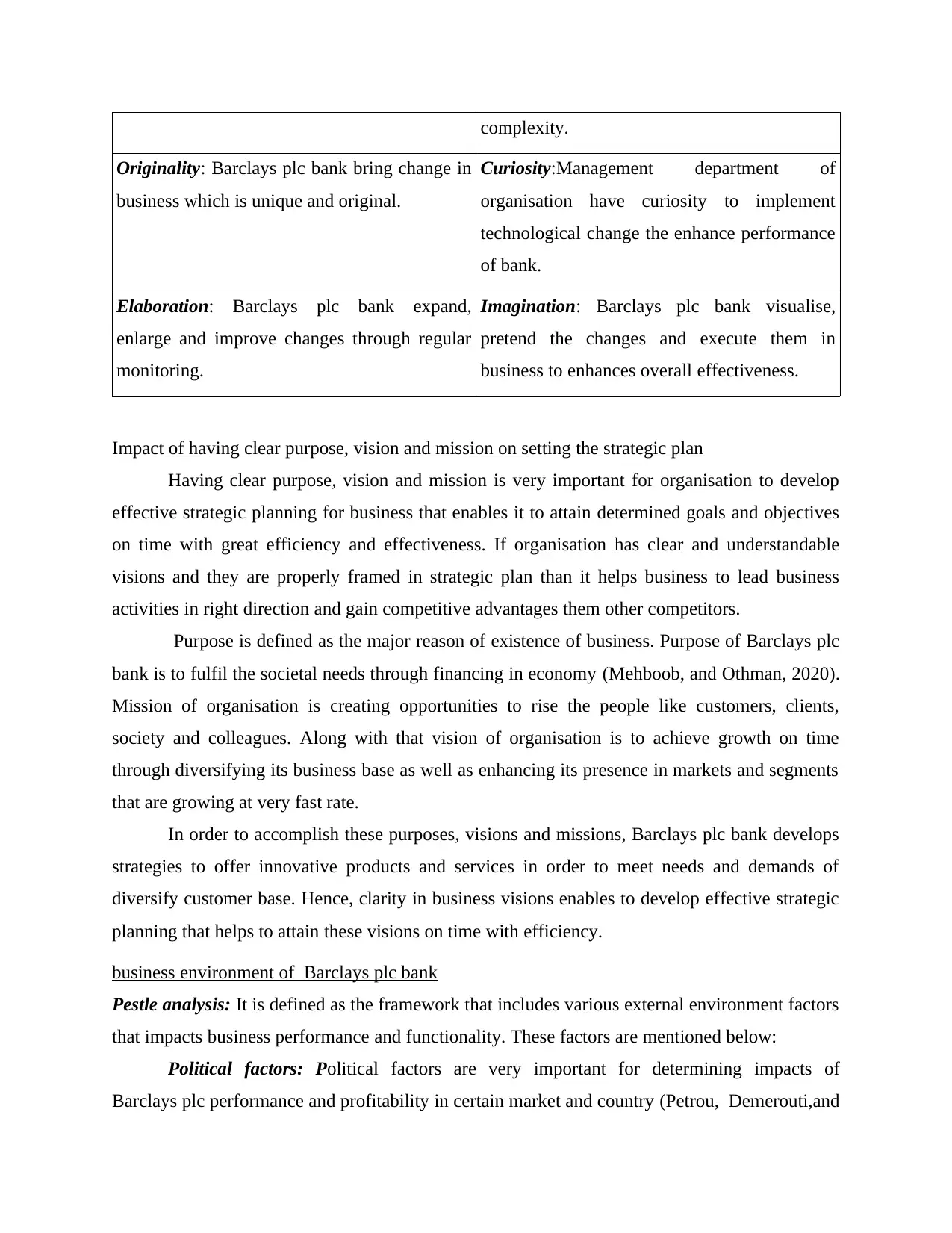
complexity.
Originality: Barclays plc bank bring change in
business which is unique and original.
Curiosity:Management department of
organisation have curiosity to implement
technological change the enhance performance
of bank.
Elaboration: Barclays plc bank expand,
enlarge and improve changes through regular
monitoring.
Imagination: Barclays plc bank visualise,
pretend the changes and execute them in
business to enhances overall effectiveness.
Impact of having clear purpose, vision and mission on setting the strategic plan
Having clear purpose, vision and mission is very important for organisation to develop
effective strategic planning for business that enables it to attain determined goals and objectives
on time with great efficiency and effectiveness. If organisation has clear and understandable
visions and they are properly framed in strategic plan than it helps business to lead business
activities in right direction and gain competitive advantages them other competitors.
Purpose is defined as the major reason of existence of business. Purpose of Barclays plc
bank is to fulfil the societal needs through financing in economy (Mehboob, and Othman, 2020).
Mission of organisation is creating opportunities to rise the people like customers, clients,
society and colleagues. Along with that vision of organisation is to achieve growth on time
through diversifying its business base as well as enhancing its presence in markets and segments
that are growing at very fast rate.
In order to accomplish these purposes, visions and missions, Barclays plc bank develops
strategies to offer innovative products and services in order to meet needs and demands of
diversify customer base. Hence, clarity in business visions enables to develop effective strategic
planning that helps to attain these visions on time with efficiency.
business environment of Barclays plc bank
Pestle analysis: It is defined as the framework that includes various external environment factors
that impacts business performance and functionality. These factors are mentioned below:
Political factors: Political factors are very important for determining impacts of
Barclays plc performance and profitability in certain market and country (Petrou, Demerouti,and
Originality: Barclays plc bank bring change in
business which is unique and original.
Curiosity:Management department of
organisation have curiosity to implement
technological change the enhance performance
of bank.
Elaboration: Barclays plc bank expand,
enlarge and improve changes through regular
monitoring.
Imagination: Barclays plc bank visualise,
pretend the changes and execute them in
business to enhances overall effectiveness.
Impact of having clear purpose, vision and mission on setting the strategic plan
Having clear purpose, vision and mission is very important for organisation to develop
effective strategic planning for business that enables it to attain determined goals and objectives
on time with great efficiency and effectiveness. If organisation has clear and understandable
visions and they are properly framed in strategic plan than it helps business to lead business
activities in right direction and gain competitive advantages them other competitors.
Purpose is defined as the major reason of existence of business. Purpose of Barclays plc
bank is to fulfil the societal needs through financing in economy (Mehboob, and Othman, 2020).
Mission of organisation is creating opportunities to rise the people like customers, clients,
society and colleagues. Along with that vision of organisation is to achieve growth on time
through diversifying its business base as well as enhancing its presence in markets and segments
that are growing at very fast rate.
In order to accomplish these purposes, visions and missions, Barclays plc bank develops
strategies to offer innovative products and services in order to meet needs and demands of
diversify customer base. Hence, clarity in business visions enables to develop effective strategic
planning that helps to attain these visions on time with efficiency.
business environment of Barclays plc bank
Pestle analysis: It is defined as the framework that includes various external environment factors
that impacts business performance and functionality. These factors are mentioned below:
Political factors: Political factors are very important for determining impacts of
Barclays plc performance and profitability in certain market and country (Petrou, Demerouti,and
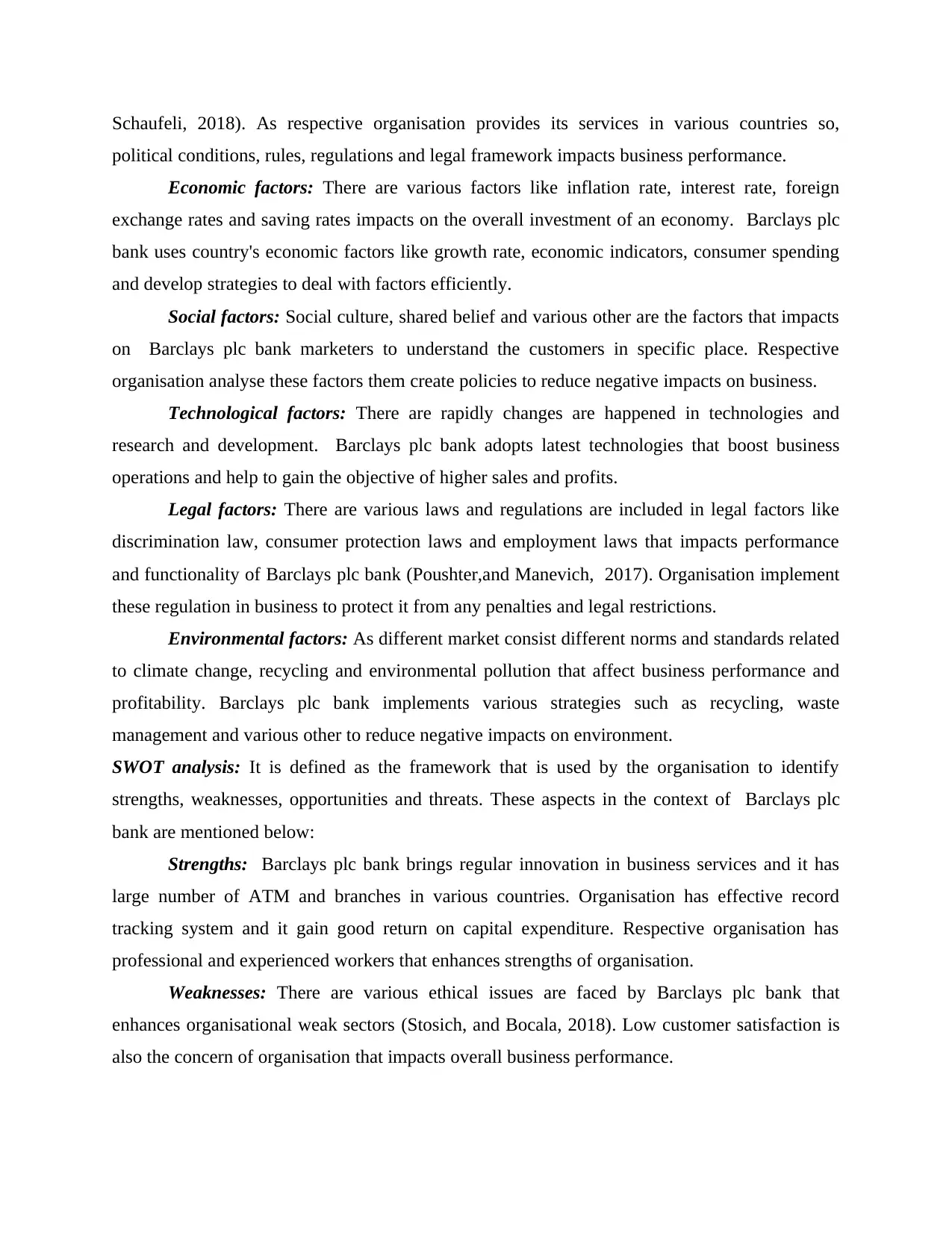
Schaufeli, 2018). As respective organisation provides its services in various countries so,
political conditions, rules, regulations and legal framework impacts business performance.
Economic factors: There are various factors like inflation rate, interest rate, foreign
exchange rates and saving rates impacts on the overall investment of an economy. Barclays plc
bank uses country's economic factors like growth rate, economic indicators, consumer spending
and develop strategies to deal with factors efficiently.
Social factors: Social culture, shared belief and various other are the factors that impacts
on Barclays plc bank marketers to understand the customers in specific place. Respective
organisation analyse these factors them create policies to reduce negative impacts on business.
Technological factors: There are rapidly changes are happened in technologies and
research and development. Barclays plc bank adopts latest technologies that boost business
operations and help to gain the objective of higher sales and profits.
Legal factors: There are various laws and regulations are included in legal factors like
discrimination law, consumer protection laws and employment laws that impacts performance
and functionality of Barclays plc bank (Poushter,and Manevich, 2017). Organisation implement
these regulation in business to protect it from any penalties and legal restrictions.
Environmental factors: As different market consist different norms and standards related
to climate change, recycling and environmental pollution that affect business performance and
profitability. Barclays plc bank implements various strategies such as recycling, waste
management and various other to reduce negative impacts on environment.
SWOT analysis: It is defined as the framework that is used by the organisation to identify
strengths, weaknesses, opportunities and threats. These aspects in the context of Barclays plc
bank are mentioned below:
Strengths: Barclays plc bank brings regular innovation in business services and it has
large number of ATM and branches in various countries. Organisation has effective record
tracking system and it gain good return on capital expenditure. Respective organisation has
professional and experienced workers that enhances strengths of organisation.
Weaknesses: There are various ethical issues are faced by Barclays plc bank that
enhances organisational weak sectors (Stosich, and Bocala, 2018). Low customer satisfaction is
also the concern of organisation that impacts overall business performance.
political conditions, rules, regulations and legal framework impacts business performance.
Economic factors: There are various factors like inflation rate, interest rate, foreign
exchange rates and saving rates impacts on the overall investment of an economy. Barclays plc
bank uses country's economic factors like growth rate, economic indicators, consumer spending
and develop strategies to deal with factors efficiently.
Social factors: Social culture, shared belief and various other are the factors that impacts
on Barclays plc bank marketers to understand the customers in specific place. Respective
organisation analyse these factors them create policies to reduce negative impacts on business.
Technological factors: There are rapidly changes are happened in technologies and
research and development. Barclays plc bank adopts latest technologies that boost business
operations and help to gain the objective of higher sales and profits.
Legal factors: There are various laws and regulations are included in legal factors like
discrimination law, consumer protection laws and employment laws that impacts performance
and functionality of Barclays plc bank (Poushter,and Manevich, 2017). Organisation implement
these regulation in business to protect it from any penalties and legal restrictions.
Environmental factors: As different market consist different norms and standards related
to climate change, recycling and environmental pollution that affect business performance and
profitability. Barclays plc bank implements various strategies such as recycling, waste
management and various other to reduce negative impacts on environment.
SWOT analysis: It is defined as the framework that is used by the organisation to identify
strengths, weaknesses, opportunities and threats. These aspects in the context of Barclays plc
bank are mentioned below:
Strengths: Barclays plc bank brings regular innovation in business services and it has
large number of ATM and branches in various countries. Organisation has effective record
tracking system and it gain good return on capital expenditure. Respective organisation has
professional and experienced workers that enhances strengths of organisation.
Weaknesses: There are various ethical issues are faced by Barclays plc bank that
enhances organisational weak sectors (Stosich, and Bocala, 2018). Low customer satisfaction is
also the concern of organisation that impacts overall business performance.
⊘ This is a preview!⊘
Do you want full access?
Subscribe today to unlock all pages.

Trusted by 1+ million students worldwide
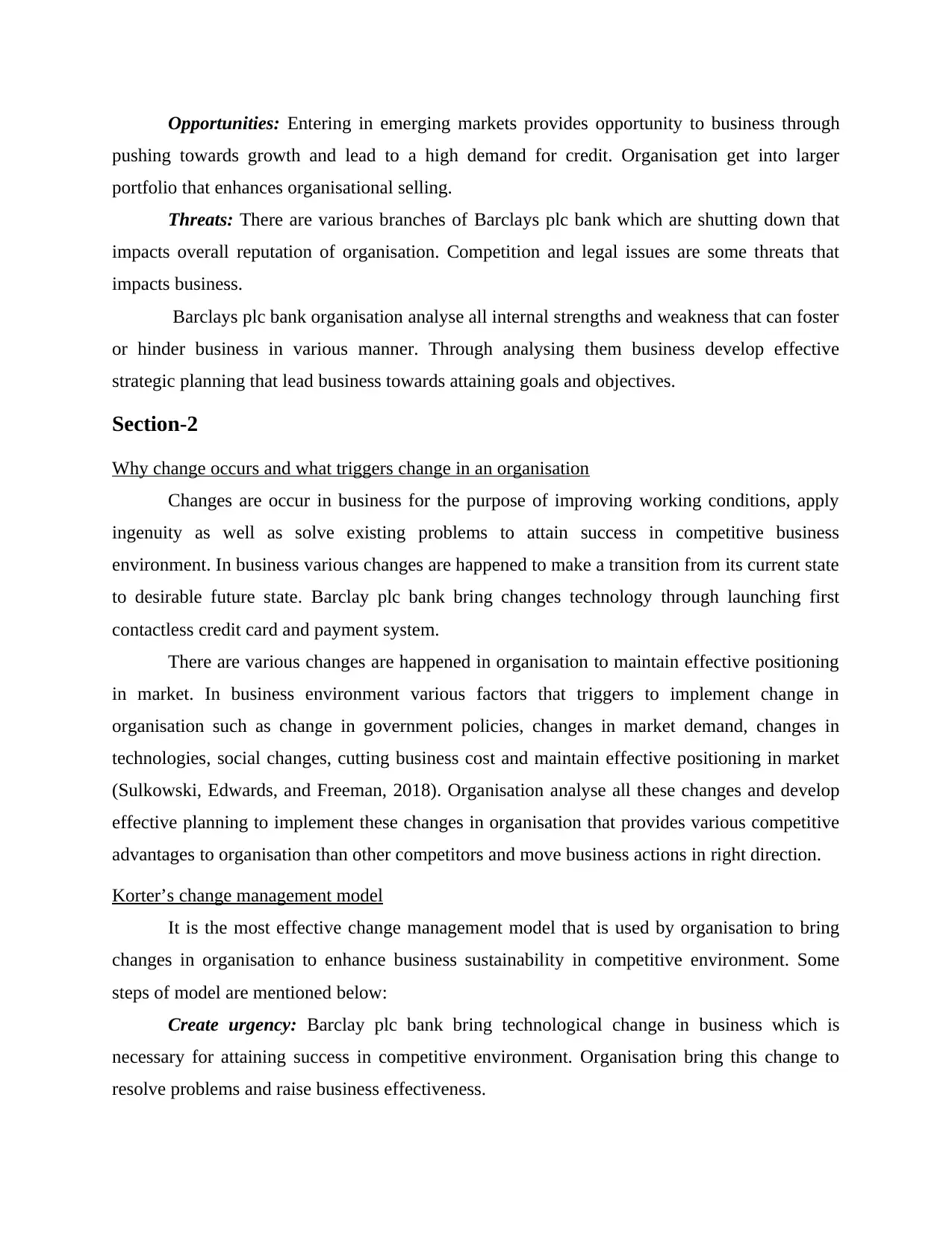
Opportunities: Entering in emerging markets provides opportunity to business through
pushing towards growth and lead to a high demand for credit. Organisation get into larger
portfolio that enhances organisational selling.
Threats: There are various branches of Barclays plc bank which are shutting down that
impacts overall reputation of organisation. Competition and legal issues are some threats that
impacts business.
Barclays plc bank organisation analyse all internal strengths and weakness that can foster
or hinder business in various manner. Through analysing them business develop effective
strategic planning that lead business towards attaining goals and objectives.
Section-2
Why change occurs and what triggers change in an organisation
Changes are occur in business for the purpose of improving working conditions, apply
ingenuity as well as solve existing problems to attain success in competitive business
environment. In business various changes are happened to make a transition from its current state
to desirable future state. Barclay plc bank bring changes technology through launching first
contactless credit card and payment system.
There are various changes are happened in organisation to maintain effective positioning
in market. In business environment various factors that triggers to implement change in
organisation such as change in government policies, changes in market demand, changes in
technologies, social changes, cutting business cost and maintain effective positioning in market
(Sulkowski, Edwards, and Freeman, 2018). Organisation analyse all these changes and develop
effective planning to implement these changes in organisation that provides various competitive
advantages to organisation than other competitors and move business actions in right direction.
Korter’s change management model
It is the most effective change management model that is used by organisation to bring
changes in organisation to enhance business sustainability in competitive environment. Some
steps of model are mentioned below:
Create urgency: Barclay plc bank bring technological change in business which is
necessary for attaining success in competitive environment. Organisation bring this change to
resolve problems and raise business effectiveness.
pushing towards growth and lead to a high demand for credit. Organisation get into larger
portfolio that enhances organisational selling.
Threats: There are various branches of Barclays plc bank which are shutting down that
impacts overall reputation of organisation. Competition and legal issues are some threats that
impacts business.
Barclays plc bank organisation analyse all internal strengths and weakness that can foster
or hinder business in various manner. Through analysing them business develop effective
strategic planning that lead business towards attaining goals and objectives.
Section-2
Why change occurs and what triggers change in an organisation
Changes are occur in business for the purpose of improving working conditions, apply
ingenuity as well as solve existing problems to attain success in competitive business
environment. In business various changes are happened to make a transition from its current state
to desirable future state. Barclay plc bank bring changes technology through launching first
contactless credit card and payment system.
There are various changes are happened in organisation to maintain effective positioning
in market. In business environment various factors that triggers to implement change in
organisation such as change in government policies, changes in market demand, changes in
technologies, social changes, cutting business cost and maintain effective positioning in market
(Sulkowski, Edwards, and Freeman, 2018). Organisation analyse all these changes and develop
effective planning to implement these changes in organisation that provides various competitive
advantages to organisation than other competitors and move business actions in right direction.
Korter’s change management model
It is the most effective change management model that is used by organisation to bring
changes in organisation to enhance business sustainability in competitive environment. Some
steps of model are mentioned below:
Create urgency: Barclay plc bank bring technological change in business which is
necessary for attaining success in competitive environment. Organisation bring this change to
resolve problems and raise business effectiveness.
Paraphrase This Document
Need a fresh take? Get an instant paraphrase of this document with our AI Paraphraser
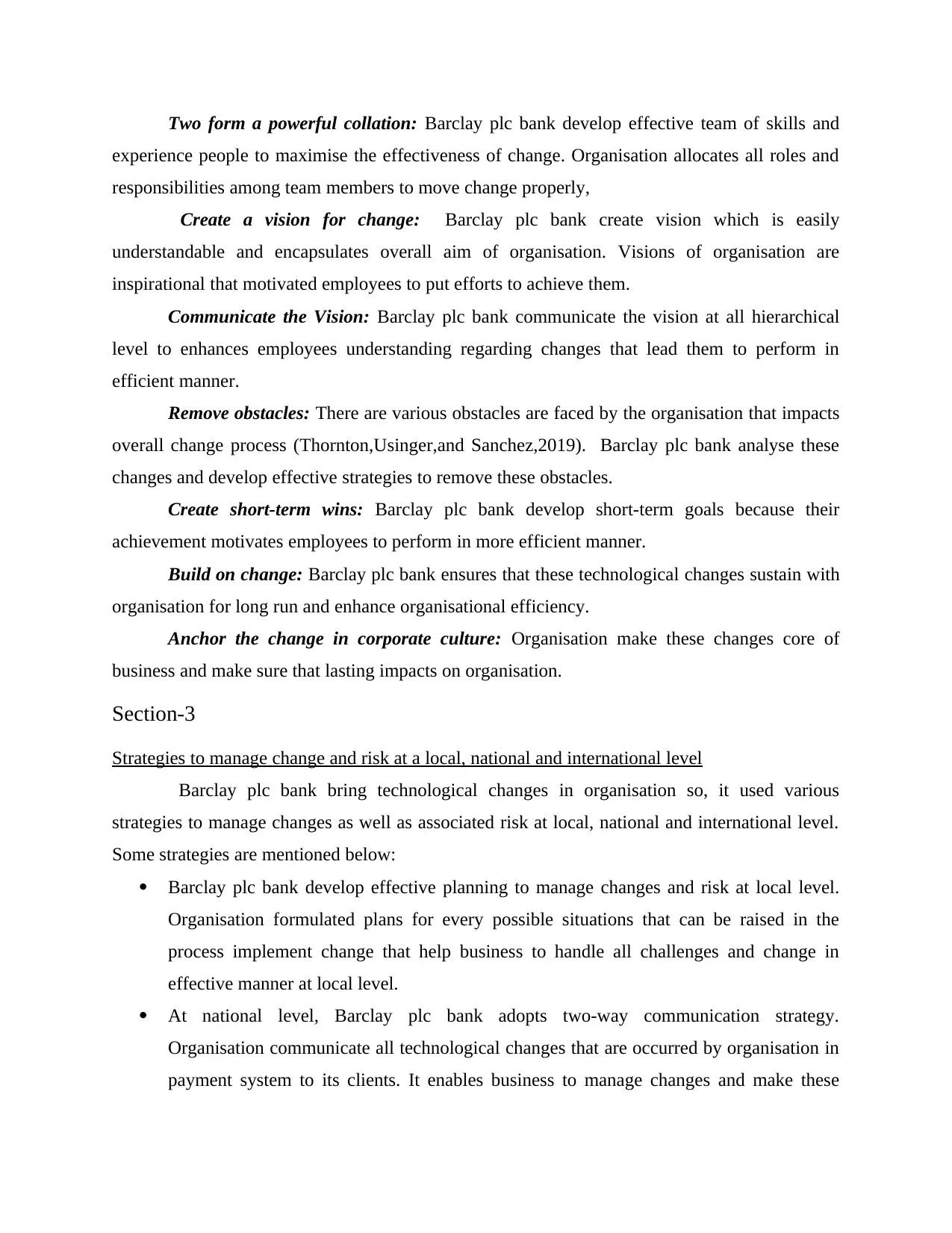
Two form a powerful collation: Barclay plc bank develop effective team of skills and
experience people to maximise the effectiveness of change. Organisation allocates all roles and
responsibilities among team members to move change properly,
Create a vision for change: Barclay plc bank create vision which is easily
understandable and encapsulates overall aim of organisation. Visions of organisation are
inspirational that motivated employees to put efforts to achieve them.
Communicate the Vision: Barclay plc bank communicate the vision at all hierarchical
level to enhances employees understanding regarding changes that lead them to perform in
efficient manner.
Remove obstacles: There are various obstacles are faced by the organisation that impacts
overall change process (Thornton,Usinger,and Sanchez,2019). Barclay plc bank analyse these
changes and develop effective strategies to remove these obstacles.
Create short-term wins: Barclay plc bank develop short-term goals because their
achievement motivates employees to perform in more efficient manner.
Build on change: Barclay plc bank ensures that these technological changes sustain with
organisation for long run and enhance organisational efficiency.
Anchor the change in corporate culture: Organisation make these changes core of
business and make sure that lasting impacts on organisation.
Section-3
Strategies to manage change and risk at a local, national and international level
Barclay plc bank bring technological changes in organisation so, it used various
strategies to manage changes as well as associated risk at local, national and international level.
Some strategies are mentioned below:
Barclay plc bank develop effective planning to manage changes and risk at local level.
Organisation formulated plans for every possible situations that can be raised in the
process implement change that help business to handle all challenges and change in
effective manner at local level.
At national level, Barclay plc bank adopts two-way communication strategy.
Organisation communicate all technological changes that are occurred by organisation in
payment system to its clients. It enables business to manage changes and make these
experience people to maximise the effectiveness of change. Organisation allocates all roles and
responsibilities among team members to move change properly,
Create a vision for change: Barclay plc bank create vision which is easily
understandable and encapsulates overall aim of organisation. Visions of organisation are
inspirational that motivated employees to put efforts to achieve them.
Communicate the Vision: Barclay plc bank communicate the vision at all hierarchical
level to enhances employees understanding regarding changes that lead them to perform in
efficient manner.
Remove obstacles: There are various obstacles are faced by the organisation that impacts
overall change process (Thornton,Usinger,and Sanchez,2019). Barclay plc bank analyse these
changes and develop effective strategies to remove these obstacles.
Create short-term wins: Barclay plc bank develop short-term goals because their
achievement motivates employees to perform in more efficient manner.
Build on change: Barclay plc bank ensures that these technological changes sustain with
organisation for long run and enhance organisational efficiency.
Anchor the change in corporate culture: Organisation make these changes core of
business and make sure that lasting impacts on organisation.
Section-3
Strategies to manage change and risk at a local, national and international level
Barclay plc bank bring technological changes in organisation so, it used various
strategies to manage changes as well as associated risk at local, national and international level.
Some strategies are mentioned below:
Barclay plc bank develop effective planning to manage changes and risk at local level.
Organisation formulated plans for every possible situations that can be raised in the
process implement change that help business to handle all challenges and change in
effective manner at local level.
At national level, Barclay plc bank adopts two-way communication strategy.
Organisation communicate all technological changes that are occurred by organisation in
payment system to its clients. It enables business to manage changes and make these
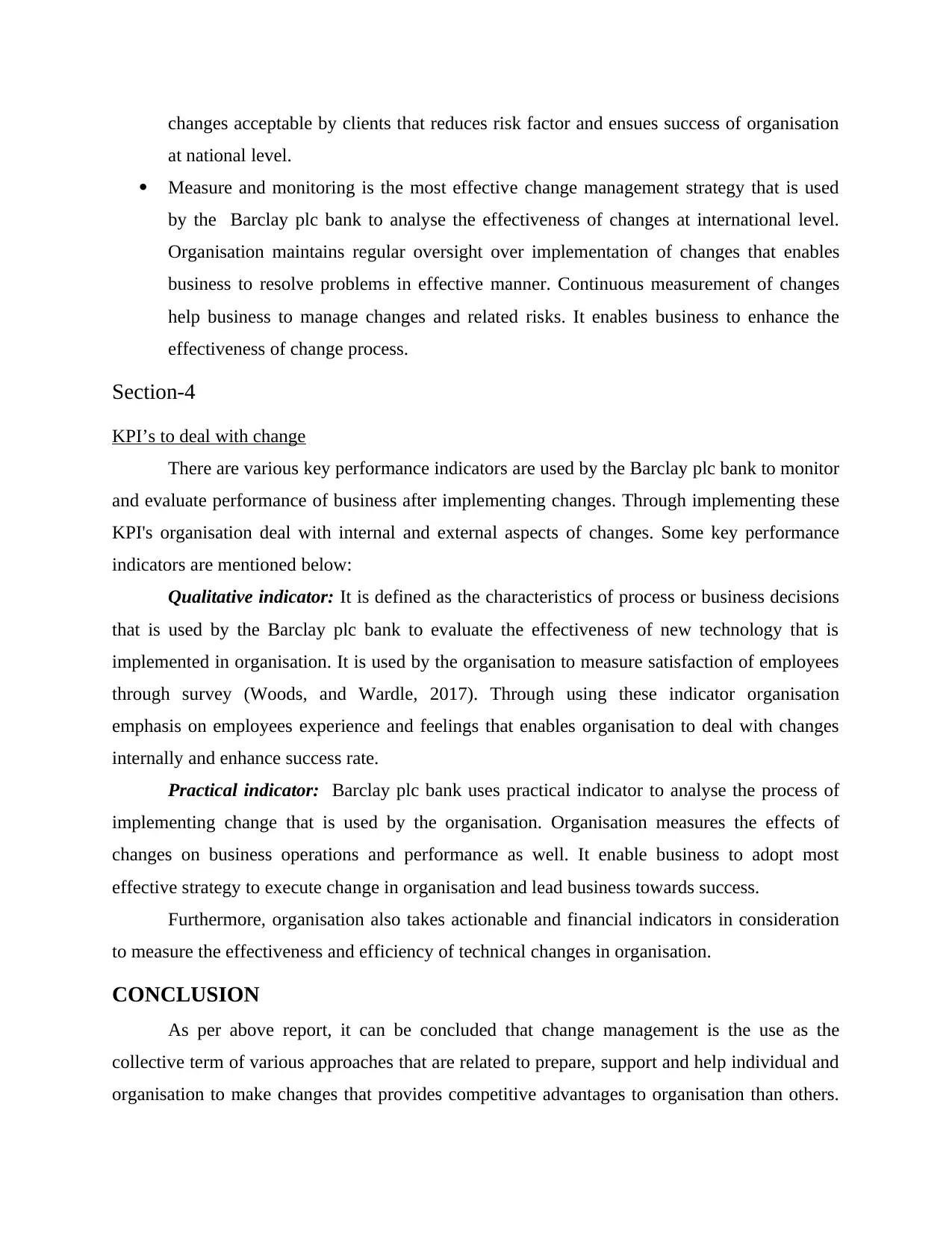
changes acceptable by clients that reduces risk factor and ensues success of organisation
at national level.
Measure and monitoring is the most effective change management strategy that is used
by the Barclay plc bank to analyse the effectiveness of changes at international level.
Organisation maintains regular oversight over implementation of changes that enables
business to resolve problems in effective manner. Continuous measurement of changes
help business to manage changes and related risks. It enables business to enhance the
effectiveness of change process.
Section-4
KPI’s to deal with change
There are various key performance indicators are used by the Barclay plc bank to monitor
and evaluate performance of business after implementing changes. Through implementing these
KPI's organisation deal with internal and external aspects of changes. Some key performance
indicators are mentioned below:
Qualitative indicator: It is defined as the characteristics of process or business decisions
that is used by the Barclay plc bank to evaluate the effectiveness of new technology that is
implemented in organisation. It is used by the organisation to measure satisfaction of employees
through survey (Woods, and Wardle, 2017). Through using these indicator organisation
emphasis on employees experience and feelings that enables organisation to deal with changes
internally and enhance success rate.
Practical indicator: Barclay plc bank uses practical indicator to analyse the process of
implementing change that is used by the organisation. Organisation measures the effects of
changes on business operations and performance as well. It enable business to adopt most
effective strategy to execute change in organisation and lead business towards success.
Furthermore, organisation also takes actionable and financial indicators in consideration
to measure the effectiveness and efficiency of technical changes in organisation.
CONCLUSION
As per above report, it can be concluded that change management is the use as the
collective term of various approaches that are related to prepare, support and help individual and
organisation to make changes that provides competitive advantages to organisation than others.
at national level.
Measure and monitoring is the most effective change management strategy that is used
by the Barclay plc bank to analyse the effectiveness of changes at international level.
Organisation maintains regular oversight over implementation of changes that enables
business to resolve problems in effective manner. Continuous measurement of changes
help business to manage changes and related risks. It enables business to enhance the
effectiveness of change process.
Section-4
KPI’s to deal with change
There are various key performance indicators are used by the Barclay plc bank to monitor
and evaluate performance of business after implementing changes. Through implementing these
KPI's organisation deal with internal and external aspects of changes. Some key performance
indicators are mentioned below:
Qualitative indicator: It is defined as the characteristics of process or business decisions
that is used by the Barclay plc bank to evaluate the effectiveness of new technology that is
implemented in organisation. It is used by the organisation to measure satisfaction of employees
through survey (Woods, and Wardle, 2017). Through using these indicator organisation
emphasis on employees experience and feelings that enables organisation to deal with changes
internally and enhance success rate.
Practical indicator: Barclay plc bank uses practical indicator to analyse the process of
implementing change that is used by the organisation. Organisation measures the effects of
changes on business operations and performance as well. It enable business to adopt most
effective strategy to execute change in organisation and lead business towards success.
Furthermore, organisation also takes actionable and financial indicators in consideration
to measure the effectiveness and efficiency of technical changes in organisation.
CONCLUSION
As per above report, it can be concluded that change management is the use as the
collective term of various approaches that are related to prepare, support and help individual and
organisation to make changes that provides competitive advantages to organisation than others.
⊘ This is a preview!⊘
Do you want full access?
Subscribe today to unlock all pages.

Trusted by 1+ million students worldwide

Organisation used various change management strategies to manage changes and there related
risk. Changes bring innovation in business and enhances their effectiveness.
risk. Changes bring innovation in business and enhances their effectiveness.
Paraphrase This Document
Need a fresh take? Get an instant paraphrase of this document with our AI Paraphraser
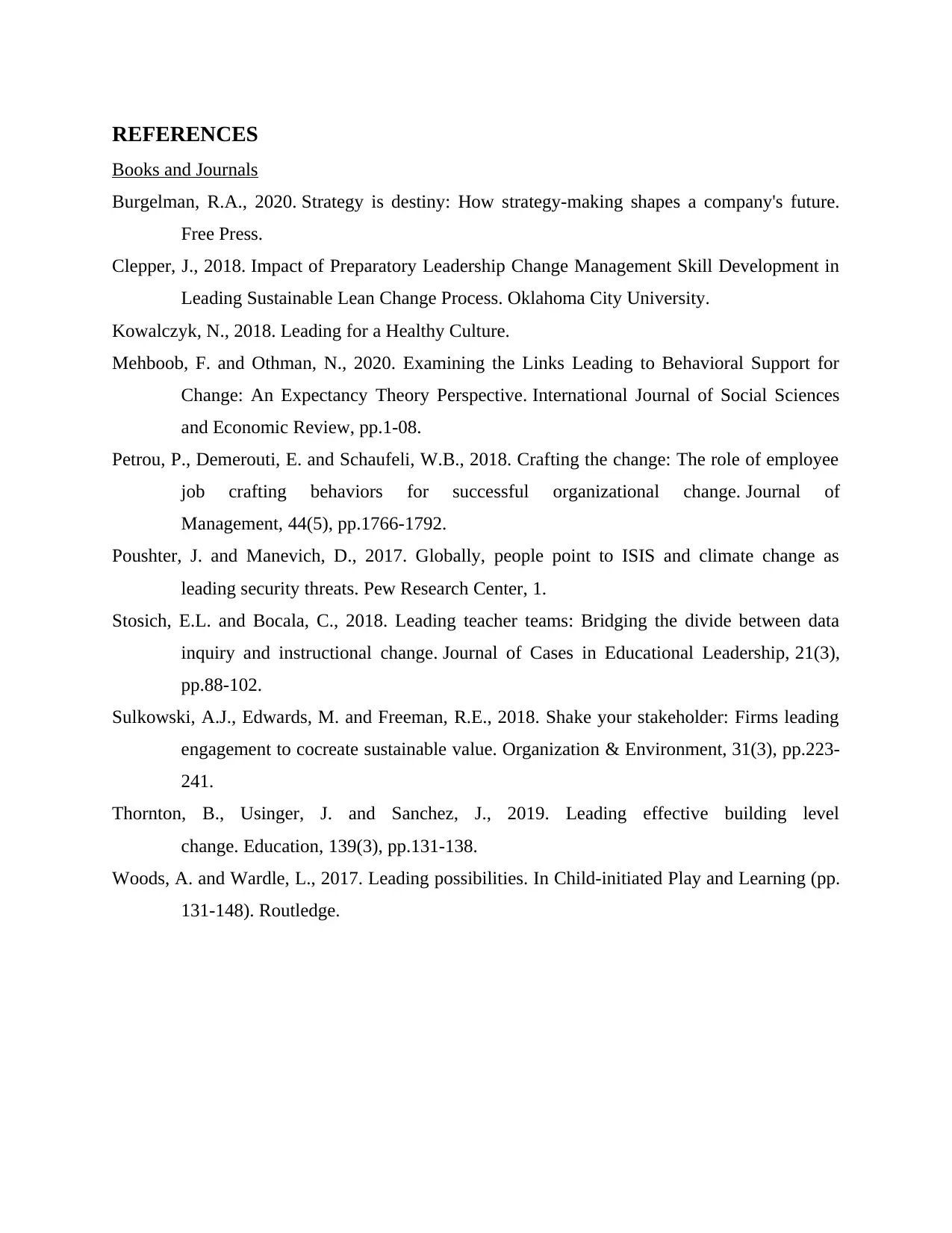
REFERENCES
Books and Journals
Burgelman, R.A., 2020. Strategy is destiny: How strategy-making shapes a company's future.
Free Press.
Clepper, J., 2018. Impact of Preparatory Leadership Change Management Skill Development in
Leading Sustainable Lean Change Process. Oklahoma City University.
Kowalczyk, N., 2018. Leading for a Healthy Culture.
Mehboob, F. and Othman, N., 2020. Examining the Links Leading to Behavioral Support for
Change: An Expectancy Theory Perspective. International Journal of Social Sciences
and Economic Review, pp.1-08.
Petrou, P., Demerouti, E. and Schaufeli, W.B., 2018. Crafting the change: The role of employee
job crafting behaviors for successful organizational change. Journal of
Management, 44(5), pp.1766-1792.
Poushter, J. and Manevich, D., 2017. Globally, people point to ISIS and climate change as
leading security threats. Pew Research Center, 1.
Stosich, E.L. and Bocala, C., 2018. Leading teacher teams: Bridging the divide between data
inquiry and instructional change. Journal of Cases in Educational Leadership, 21(3),
pp.88-102.
Sulkowski, A.J., Edwards, M. and Freeman, R.E., 2018. Shake your stakeholder: Firms leading
engagement to cocreate sustainable value. Organization & Environment, 31(3), pp.223-
241.
Thornton, B., Usinger, J. and Sanchez, J., 2019. Leading effective building level
change. Education, 139(3), pp.131-138.
Woods, A. and Wardle, L., 2017. Leading possibilities. In Child-initiated Play and Learning (pp.
131-148). Routledge.
Books and Journals
Burgelman, R.A., 2020. Strategy is destiny: How strategy-making shapes a company's future.
Free Press.
Clepper, J., 2018. Impact of Preparatory Leadership Change Management Skill Development in
Leading Sustainable Lean Change Process. Oklahoma City University.
Kowalczyk, N., 2018. Leading for a Healthy Culture.
Mehboob, F. and Othman, N., 2020. Examining the Links Leading to Behavioral Support for
Change: An Expectancy Theory Perspective. International Journal of Social Sciences
and Economic Review, pp.1-08.
Petrou, P., Demerouti, E. and Schaufeli, W.B., 2018. Crafting the change: The role of employee
job crafting behaviors for successful organizational change. Journal of
Management, 44(5), pp.1766-1792.
Poushter, J. and Manevich, D., 2017. Globally, people point to ISIS and climate change as
leading security threats. Pew Research Center, 1.
Stosich, E.L. and Bocala, C., 2018. Leading teacher teams: Bridging the divide between data
inquiry and instructional change. Journal of Cases in Educational Leadership, 21(3),
pp.88-102.
Sulkowski, A.J., Edwards, M. and Freeman, R.E., 2018. Shake your stakeholder: Firms leading
engagement to cocreate sustainable value. Organization & Environment, 31(3), pp.223-
241.
Thornton, B., Usinger, J. and Sanchez, J., 2019. Leading effective building level
change. Education, 139(3), pp.131-138.
Woods, A. and Wardle, L., 2017. Leading possibilities. In Child-initiated Play and Learning (pp.
131-148). Routledge.

⊘ This is a preview!⊘
Do you want full access?
Subscribe today to unlock all pages.

Trusted by 1+ million students worldwide
1 out of 14
Related Documents
Your All-in-One AI-Powered Toolkit for Academic Success.
+13062052269
info@desklib.com
Available 24*7 on WhatsApp / Email
![[object Object]](/_next/static/media/star-bottom.7253800d.svg)
Unlock your academic potential
Copyright © 2020–2025 A2Z Services. All Rights Reserved. Developed and managed by ZUCOL.




